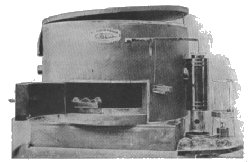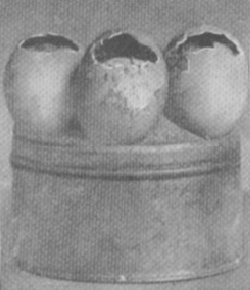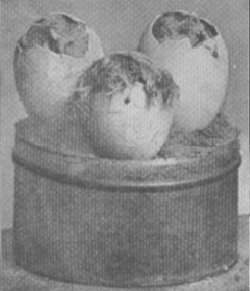|
The process is a very simple one. The only articles necessary are a close box, a quantity of stick sulphur and a pan to use it in. Collect enough flowers to fill a half peck basket and then obtain a square wooden box, like those in which tea is packed. Across the, inside of the top of this tack two narrow strips of wood on opposite sides, upon which rest rods or strips for the bunches of flowers to hang from. The box must be air-tight; but as the burning sulphur would very quickly consume the oxygen of the air contained in it, and extinguish the fire, a hole or two must be bored, or a small door cut, in the lower part of one side. These may be closed or opened at will,—the former by means of plugs and the latter, with hinges. Arrange the flowers in loose clusters of from two to a dozen, according to size; two dahlias, passion flowers or callas, four half-blown roses, or two or three full blown, a spray or two of fuchsias, or larkspur, pinks or lantanas, one or two camellias, a dozen forget-me-nots or lilies of the valley, mignonette and so on, according to the size. Hang each cluster, as tied, upon the rods, not touching each other. There will be room enough for about four rows. In an iron pan put a shovel partly full of clear, live coals, spreading them over the bottom, and place it on the bottom of the box. Then sprinkle over the whole surface about two ounces of crushed sulphur and the process is begun. Leave the holes, or little door, open for a few minutes, until all progresses favorably and there is an abundance of sulphur fumes, then close the box tightly and envelop it, top and bottom, with a blanket or piece of heavy, thick carpet and leave it undisturbed for 24 hours. If all has gone well the flowers will appear quite perfect in form, but bleached to a dull, creamy-white shade. This, upon exposing to a pure air in a dry place, they gradually lose, and assume their natural tints, although not so intense in shade as before the bleaching. If the box has been made perfectly airtight by sealing up all the edges, and has been kept in a dry room, the flowers thus treated, if tastefully arranged under a shade or in a recess, will retain their perfection of form and color for any length of time. GATHERING CORK The cork tree belongs to the class of oaks, and grows in the impenetrable forests of Spain, in the southwestern portion of France, in Algiers and in Senegambia. There are two trees, quercus suber and quercus occidentalis, that, from time to time, shed their bark or outer coating. This coating covers the cork of trade; but the bark shed by nature is not marketable, because it does not contain any sap, which is necessary to retain the elasticity. Cork for industrial purposes is gained by peeling. After a tree, is three years old, the, peeling may commence; but cork of that age is of inferior quality, and the peeling would kill the tree. Trees of twenty years growth give cork of a fair quality, improving until the tree has gained the respectable age of 100 or 150 years, when the bark becomes hard and unwieldy. Circular incisions are made around the trunk of the tree, which are connected by perpendicular cuts, allowing the two half circles to be removed. Care must be taken not to disturb the fiber, or inner bark, which keeps the tree alive. The peeling process can be repeated on the same tree at intervals of from eight to ten years, yielding cork plates from one to four inches in thickness. The half round cork pieces are pressed into plates while still moist from the tree. Then the rough coatings are removed, and the plates are immersed in boiling water for several minutes and pressed again. After that they are piled in bundles, fastened by iron hoops, and are ready for the market. The raw material will sell from four to 70 cents per pound, according to the quality and thickness. The full-grown cork tree reaches a height of 70 feet, and a diameter of five feet. The quality of the cork depends very much upon the lay of the land, —that exposed to the greatest heat being the finest. Each tree yields cork of two dimensions,—the bark on the northern side of the tree being the thinnest. The imported tree is said to thrive in some portions of the United States, but the region of the Pyrenees supplies most of the world's demand for the cork of commerce. The tree blossoms in April or May; the fruit ripens from September to January, falling on the ground as soon as ripe. The acorns are edible, and resemble chestnuts in taste. Cork intended for the market is generally stripped off a year or two before it would naturally come away. The cork of the first barking, which is removed usually when the tree is about twenty-five years old, is known as the virgin bark. The taking of this bark rather promotes the health of the tree. The average yield of commercial cork is about 45 pounds to one tree. Aside from stopping bottles and casks, cork is used for floats of nets, swimming belts, etc., and for inner soles of shoes. The waste bits are made into linoleum. The Spanish black used by painters is made by burning cork in close vessels. ARTIFICIAL HATCHING OF CHICKENS
The methods of heating have heretofore mainly been by warm air from a lamp, and by a tank of lamp-heated water. The eggs are carefully sorted, those laid in the latter part of the laying period being left out on account of their deficient vitality. Ordinary incubators have a capacity for 600 eggs each, but some have been made which hatch thousands at once. The heat generated varies from 102 to 104 degrees. Under the hen, the heat is rarely as much as 100 degrees until the ninth or tenth day; her temperature is from 106 to 110 degrees, but that of the eggs seldom exceeds 103°. In order that the temperature of the eggs may reach 102°, the air in the incubator immediately over them is kept about 103° until the first half of the hatching term is reached. Then it is allowed to decrease gradually. The large end of the eggs, which contains the germ is placed uppermost, and during the process the position of the eggs is ordinarily changed, and they are also turned twice a day. The period of artificial incubation is 22 days.
After the incubator comes the brooder, a contrivance heated by the same method as the former. The warmth is sometimes applied from the bottom, but generally f rom the side. In the brooder the incipient fowl is developed into a condition for self-support, food and water being first given from two to three days after the hatching. HOW CELLULOID IS MADE |


